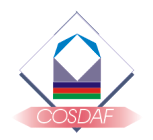Organic Light Emitting Diode
Nanotechnology-Enabled Organic Light Emitting Devices for Decorative and Special-effect Lighting Purposes
Funding Source and Organization
Innovation and Technology Fund, by the Innovation and Technology Commission of the Hong Kong
Project submitted by
Nano and Advanced Materials Institute Limited
Principal Coordinator
Team Members
Professor S.T. Lee (Deputy project coordinator)
Dr. N.B. Wong
Dr. H.L. Kwong
Dr. M.K. Fung
Dr. F.L. Wong
Collaborating Parties
Technical Institute of Physics and Chemistry, CAS, China
Shenzhen ASIC Micro-Electronics Limited, China
Bona Fide Industrial Company Limited, Hong Kong
Liaoning Juzhi Technology Development Company Limited
Award
ITF Share: HK$3,157,900; Sponsorship Share: HK$360,000
Project Period
27/6/08 - 26/06/10
The project aims to extend organic light emitting technology into a new product platform for general lighting and design lighting for household. The major technical obstacles that must be tackled for lighting include lifetime, output intensity, and tunable color temperatures of the devices. To achieve the goal, the team at CityU plans to utilize unique properties of nanostructural materials to fabricate high-efficiency and long-lifetime white-emitting organic light-emitting devices (WOLEDs) by exploiting the technologies in triplet emission, stable emitters, optical coupling, stack cells, low operating voltage materials and structures, etc. We target at delivering practical WOLED with power efficiency greater than 20 lm/W and that of incandescent light sources. It is expected that within the next 10-15 years, OLED will replace the bulk of conventional light sources because of their advantages in longer lifetime, lower power consumption, potential of flexibility, and environmental friendliness (no mercury). The team at CityU already has an outstanding track record in the field of OLED and is equipped with a comprehensive set of OLED infrastructure and facilities. The proposed project will buttress the lighting infrastructure and technology base in Hong Kong and China.
Deliverables of the project
- Novel materials low cost for high-efficiency WOLED
- Design and synthesis of blue dopant and host materials with cost at least 30% lower than typical commercial materials used in phosphorescent OLED
- Fabrication of blue PHOLED with current efficiency greater than 10 cd/A, CIE (x,y) = (0.15-0.25, 0.15-0.25)
- Demonstration of scalable nanotechnology-enabled WOLED prototypes with the following specifications:
- Prototypes on 2" and scalable up to 6" glass substrate
- Power efficiency greater than 12 lm/W
- Operation Lifetime longer than 1,000 hours at initial brightness of 1,000 cd/m2
- Luminance greater than 10,000 cd/m2
- CIE (x,y): (0.3-0.45, 0.3-0.45)
- High-efficiency, colorful OLED for decorative and special-effect lighting purposes with the following specifications:
- Emitting colors: either single or multi-colors from red, green, blue, yellow, white or orange
- Luminance greater than 4,000 cd/m2 for green, yellow and white, or greater than 1,000 cd/m2 for red, blue or orange





